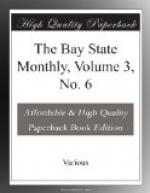Early in 1735 the settlement of Newbury (then spelled Newberry) was begun. In a little over three years a colony was sent out across the Merrimac. The plantation was at first called merely from the name of the river. In 1639 it was named Colchester by the General Court; but October 7, 1640, this name was changed to Salisbury, so that in 1638, almost two hundred and fifty years ago, Salisbury began to be settled. It seemed as if there was need of new settlements at that time to counteract the depletions in the Old World, for the Thirty Years’ War was still impoverishing Germany; Richelieu was living to rule France in the name of his royal master, Louis XIII; England was gathering up those forces of good and evil which from resisting tyranny at last grew intoxicated with power, and so came to play the tyrant and regicide. For it was about that time that Charles I had disbanded his army, trusting to the divinity that, in the eyes of the Stuarts, did ever hedge a king, and at the same time thrown away his honor by pledging himself to what he never meant to perform. While this farce, which preceded the tragedy, was being set upon the stage of history, here, three thousand miles away, nature had begun to build up the waste, and to prophesy growth.
Salisbury, and afterwards Amesbury, were named from the two towns so famous in England, the Salisbury Plain of Druidical memory, on which is the celebrated Stonehenge, and near by, the Amesbury where was one of the oldest monasteries in England. It is supposed that the towns were so named because many of the new settlers came from those old English towns. The latter name used to be spelled Ambresbury, and Tennyson in his “Idylls of the King” spells Almesbury. After the discovery by Modred of the guilt of King Arthur’s fair and false wife, he says:—
“Queen Guinevere had fled the court
and sat
There in the holyhouse at Almesbury
Weeping.”
Describing her flight, he tells us that she sent Lancelot
“Back to his land, but she to Almesbury
Fled all night long by glimmering waste
and weald.”
There Arthur sees her for the last time and mourns over her before he goes forth to his last battle with Modred.
On the whole, it is not strange, considering its associations, and moreover the fact that this town in Massachusetts is the only Amesbury in America while so many other names are duplicated, that the people of Amesbury are not willing to merge the name of their town into that of the elder sister, even when those parts called in each “the Mills” are so closely united in interests and in appearance that no stranger could recognize them as two towns. It is only the Powow that makes the dividing line here. Blocks of offices and stores on both sides of the street, among them the post-office, common to both towns, hide the narrow stream at that point, and further up and down the towering walls of the factories make it unobserved. It is not here that one sees the Powow. But there is, or a little time ago there was, a place not far off from this main street where the river is still harassed, yet as it slips past in its silent toil with a few trees hanging low on the right, it has a fascination in spite of its prosaic surroundings; it takes naturally to picturesqueness and freedom.




